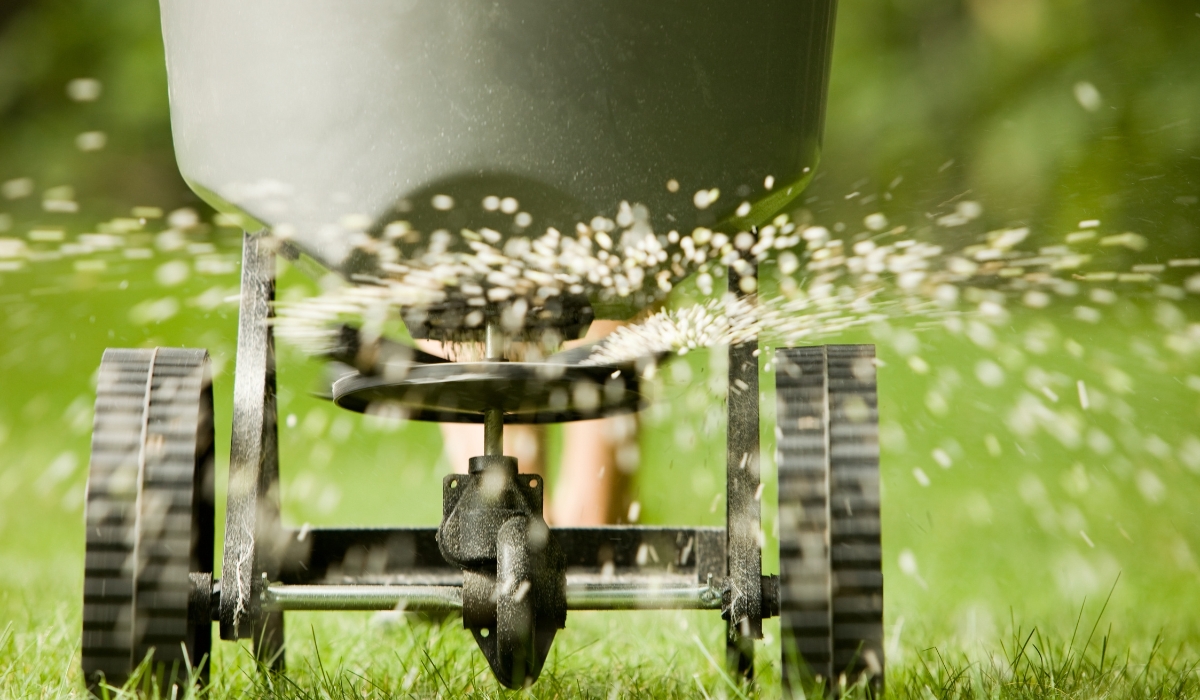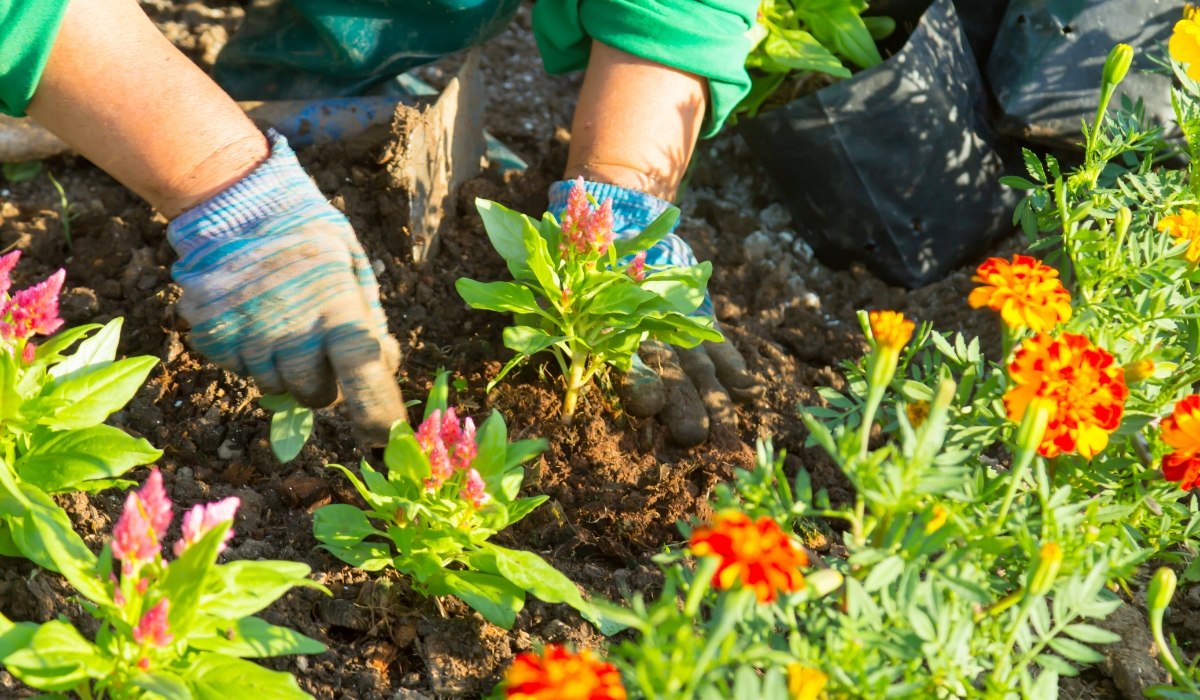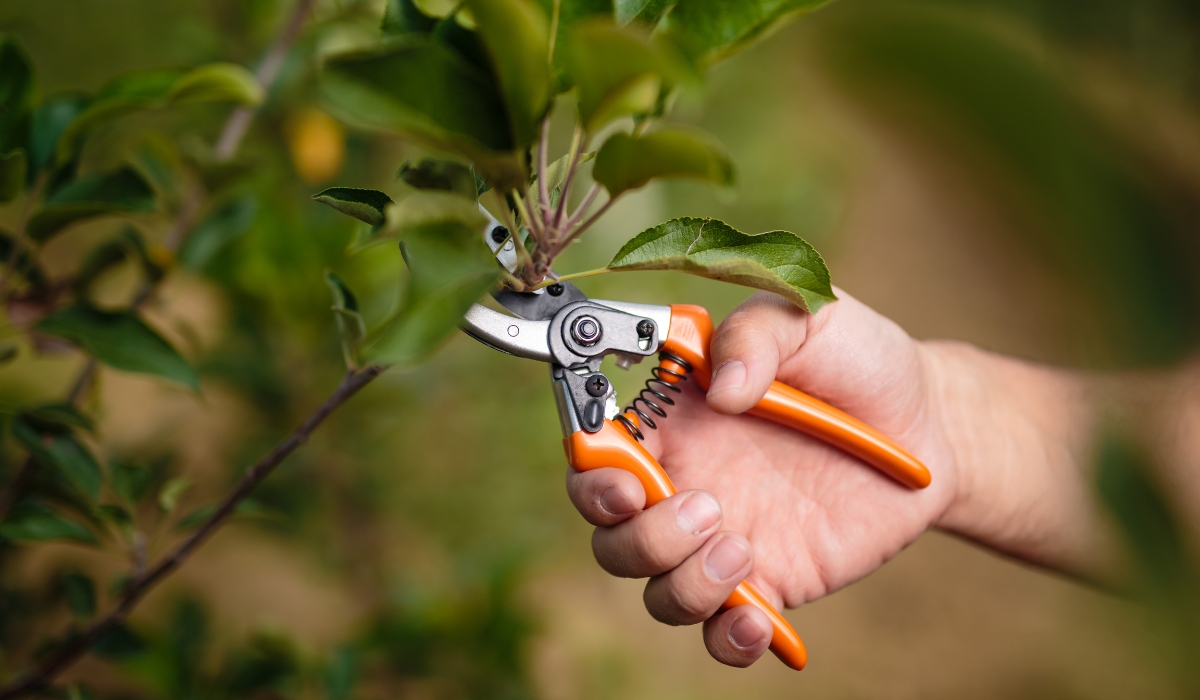Archive for Fertilizer
September Lawn Recovery: Repairing Summer Damage for a Greener Fall

1. Aerate Your Lawn to Relieve Compaction
2. Overseed Thin or Bare Areas
3. Feed Your Lawn for Recovery
4. Address Weeds and Thatch
5. Water Consistently During Recovery
6. Maintain Good Lawn Practices
Trust the Experts for Lasting Results
Designing Your Dream Spring Garden: Inspiration from DK Landscaping for March

As the landscape awakens in March, it’s the perfect time to not only tend to essential gardening tasks but also to dream and design the spring garden you’ve always envisioned. At DK Landscaping, we believe that thoughtful planning and creative inspiration are key to creating outdoor spaces that bring joy and beauty throughout the season.
This March, let’s explore some inspiring ideas and design considerations to help you craft your dream spring garden, with guidance and inspiration from the experts at DK Landscaping.
Embracing Color and Fragrance:
- Layering Spring Blooms: Create a tapestry of color by layering different spring-blooming plants with varying heights and bloom times. Start with early bloomers like daffodils and tulips, followed by mid-season favorites like irises and peonies, and then late-spring beauties like roses and foxgloves.
- Adding Fragrant Flowers: Engage your senses by incorporating fragrant spring blooms such as lilacs, hyacinths, sweet peas, and stock. Place them near walkways, patios, or windows where their delightful scents can be easily enjoyed.
- Creating Themed Color Palettes: Consider designing specific garden areas with a cohesive color palette. For example, a serene blue and white garden with forget-me-nots, white tulips, and bluebells, or a vibrant warm-toned bed with red poppies, orange calendula, and yellow daffodils.
Designing for Structure and Flow:
- Defining Garden Beds and Borders: Create clear definition between your lawn, pathways, and planting beds using edging materials like stone, brick, or metal. This adds a sense of order and visual appeal to your garden.
- Incorporating Vertical Elements: Add height and visual interest by incorporating vertical elements such as climbing roses on trellises, clematis vines on arbors, or tall flowering spires like delphiniums and snapdragons.
- Creating Pathways and Focal Points: Design inviting pathways that encourage exploration of your garden. Create focal points with striking plants, unique sculptures, or charming water features to draw the eye and add personality.
Considering Functionality and Enjoyment:
- Designing Outdoor Living Spaces: Extend your living space outdoors by creating comfortable seating areas, dining nooks, or even an outdoor kitchen. Consider the placement of these areas in relation to sunlight, shade, and prevailing winds.
- Attracting Pollinators: Design your garden with pollinators in mind by including a variety of nectar-rich flowers that attract bees, butterflies, and hummingbirds. Include native plants whenever possible.
- Creating a Cutting Garden: If you enjoy bringing fresh flowers indoors, dedicate a section of your garden to growing cut flowers like zinnias, cosmos, sunflowers, and dahlias.
Getting Started with Your Spring Garden Design:
- Assess Your Existing Space: Take a good look at your current garden, noting sunlight patterns, soil conditions, and existing plants.
- Gather Inspiration: Browse gardening books, magazines, websites, and social media platforms for ideas and inspiration that resonate with your style and local climate.
- Sketch Your Ideas: Create a rough sketch of your desired garden layout, noting the placement of different plants and features.
- Consult with the Experts: If you need help bringing your spring garden vision to life, the design team at DK Landscaping is here to provide expert advice and create a customized plan for your outdoor space.
Let DK Landscaping help you design and cultivate the spring garden of your dreams this March!
Contact us today for a consultation and let’s bring your vision to full bloom.
Pro Tips For Sustainable Yard Maintenance
A well-maintained, healthy, and vibrant yard is a joy to look at and a pleasure to enjoy. It boosts curb appeal, increases property value, and contributes to community pride. If you’re looking for the best ways to maintain a beautiful yard without wasting resources or harming the environment, then it’s time to start thinking sustainably.
By implementing sustainable yard maintenance practices, you can save water, money and protect the environment from ecological damage. Whether you’re a developer looking to uphold the value of your properties or a homeowner seeking to create the perfect entertaining spot, these pro tips will help you take care of your yard in a responsible way:

Design a Water-Wise Landscape
Water scarcity is an increasing problem in parts of the world, with over two-thirds of the world’s population experiencing severe water scarcity for at least one month each year. This is why we must consider sustainable ways to keep your yard lush year-round.
You can conserve water used to maintain your yard by:
- Reducing and reusing water
- Increasing surface coverage
- Investing in an efficient irrigation system
- Choosing drought-resistant plants
- Incorporating rainwater harvesting systems
But before you start, it’s important to create a plan that takes into account the type of soil, climate, and region you live in. Here’s where a landscape design professional specializing in creating beautiful, water-saving yards comes in.
An experienced yard maintenance Rohnert Park landscaper will consider the Sonoma-Marin Saving Water Partnership design standards to create a sustainable and water-wise landscape that enhances the beauty of your outdoor space.
Practice Regular Yard Maintenance
If you want a yard that looks picture-perfect all the time, then regular maintenance is essential. You don’t have to invest a ton of money – there are sustainable ways to make sure your yard is thriving:
Mowing Your Lawn
Regularly mowed grass will stay healthier than grass allowed to overgrow and go weeks between mowings. Sustainable yard maintenance means ensuring your blade is sharp and not cutting off more than 1/3 of the grass blade at any given time.
Edging Your Yard
Have you ever noticed how professional landscapers make those crisp borders between the lawn and surrounding beds? That’s because they’re adept at using sophisticated edging tools for precision work around gardens, pathways, and driveways to give the yard distinction between different landscape design elements.
Pruning & Weeding Your Yard
Regular pruning removes dead or diseased branches to promote the healthy growth of flowering plants and vegetation in your garden. As far as weeds go – those pesky little buggers can sprout up even after you think you’ve gotten rid of them! To prevent weeds from regrowing and keep plants looking their best all season long, consider hiring a landscaping company with access to sustainable weed control methods like mulching.
Mulch It Up
Mulching can help reduce water loss due to evaporation and keep weeds from growing in between plants, which helps prevent competition for resources like water and nutrients from the soil. Top off your mulch every few months since it naturally degrades over time.
Choose Eco-Friendly Products
What you use to treat your plants and lawns can make a huge difference in the eco-friendliness of your yard maintenance routine. Whether it’s weed killer, fertilizer, or bug spray, you should always check the ingredients and assess their environmental impact.
Here are some pro tips for eco-friendly yard maintenance:
- Opt for organic fertilizers that contain composted organic materials such as plant residues, vegetable matter, and manure instead of synthetic fertilizers.
- Try using natural pest control techniques such as installing bird baths to attract predatory birds that eat harmful insects, companion planting (growing certain plants together to ward off pests), and using sticky traps instead of chemical pesticides.
- Request the landscaper to use slow-release fertilizers with fewer synthetic chemicals and minimally toxic herbicides instead of traditional products filled with harsh chemicals, which damage the environment in the long run.
Repair and Replace When Necessary
Sometimes, despite our best efforts, certain things in your yard just won’t last. Whether it’s a badly rusted sprinkler head or dying shrubs and trees, it pays to be proactive and invest in repairs or replacements.
The first thing to do is to diagnose the problem. You can do this by evaluating the structure’s condition by checking for signs of decay, metal rust, holes, and gaps in the grass. It’s best to have an expert provide an assessment.
Once you have a professional evaluation, you can decide whether to repair or replace the structure. If the system is relatively new, a repair is advisable. But if the design is over a few years old, you may need to replace it with an updated, much more durable model.
Find Yard Maintenance Services
Pursuing sustainable yard maintenance is easy with the right tips and tricks. Utilizing tools such as water-saving irrigation systems, native plants, and organic fertilizers is key for any Rohnert Park homeowner looking to maintain a beautiful and sustainable outdoor environment.
We provide small-scale and large-scale yard maintenance services focusing on sustainability and efficiency. We understand the importance of using eco-friendly practices while keeping your landscape looking beautiful and healthy year-round! Contact us today for more information about our sustainable yard maintenance services!
Fertilizer & Xeriscape: Tips To Help Your Landscape Thrive
One of the bonuses of a water-saving (xeriscape) landscape is that it needs less fertilizer than its water-thirsty counterparts. However, soil health is essential to the healthy lifecycle of your garden’s flower plants, shrubs, and trees. When soil becomes depleted, plants begin to starve, so regular fertilizer applications prevent soil depletion altogether.
A depleted plant has a higher risk of succumbing to disease and is less able to combat common pests. By using suitable fertilizer, at the correct times, home and business owners ensure their living landscapes have what they need to thrive.

Xeriscape Fertilizing: Information & Tips
The more you learn about soil, plant needs, and the ins and outs of fertilizers, the better equipped you are to nourish your landscape as needed.
1. Fertilizing needs depend on soil quality
Plants, shrubs, and trees depend on about 16 mineral elements for their “nutrition.” They get most of the oxygen, nitrogen, carbon, and hydrogen they need from the air and water. However, plants depend on soil to deliver the rest. The most necessary of these elements are:
- Nitrogen
- Phosphorus (P)
- Potassium (K)
If you worked with a xeriscape landscape designer, you might remember they focused on soil analysis. Part of this analysis was to learn more about the mineral element balance in the existing soil. From these results, they used amendments to create a richer soil biome. Over time, plants consume essential minerals leaving soil depleted without additional fertilizer boosts.
If it’s been a while since your soil was tested, or you aren’t sure where to start, it’s worth having your soil tested in different landscape areas. First, mark them well, so you know where they came from, and then have them tested at a local nursery or through a landscape professional that offers soil testing. This is the best way to learn precisely what your soil needs, after which you can select customized fertilizer treatments and amendments.
2. Select eco-friendly fertilizers
Xeriscapes inherently support their environments. They’re designed to honor the water available on-site and from the average area rainfall, with minimal input through irrigation. And because we use native plant species, waterwise landscaping is also designed to attract pollinators and other wildlife, creating an eco-friendly habitat. Therefore, the fertilizers you select can make or break the entire plan.
Always select organic or eco-friendly fertilizers that use minimal to no chemicals or synthetic ingredients. This minimizes the risk of nutrient runoff into rivers, lakes, and streams or toxic poisoning of crucial insects, pollinators, and soil microbes.
3. Understanding the numbers
Remember we said the three essential mineral elements for plants and trees are nitrogen, phosphorous, and potassium? When you purchase fertilizer for your landscape, the container will have numbers representing each product’s ratio of Nitrogen: Phosphorous: Potassium. Some of these ratios are set for “general” fertilizer, while others are specific to flowering and fruiting plants, leafing plants, particular types of grass, etc.
You’ll also notice that some of the most commercially-known fertilizers have very high ratios (like 11:7:7 or 15:9:12). In contrast, organic or eco-friendly fertilizers have lower numbers (more like 6:3:2 or 3:2:3). That’s because most commercial fertilizers are artificially loaded with powerful chemicals to achieve immediate results. Organic/eco-friendly brands use animal and plant residues.
The less powerful, but better for the environment, alternatives are fine for a well-maintained xeriscape. With Xeriscape, less is more in every way. That includes less water and less need for fertilizers. The continuity of proper, organic fertilizer application yields consistent, long-term results with virtually zero harmful effects on beneficial organisms.
4. Fertilizer timing is important
In almost all cases, we recommend fertilizing plants, trees, and shrubs twice yearly: once in fall and once in spring. This achieves a balance where wintering roots have access to nutrients as they gear up for their re-emergence in spring. Then, once dormant winter plants come back to life, a spring dose of fertilizer gives them the extra nutrients they need to produce lush foliage and flowers through the summer.
Bring your plant list or xeriscape design map to a local nursery, and they’ll help you select specific fertilizers as necessary. However, you can also purchase a general, all-purpose organic fertilizer and apply it as directed if you prefer to keep things simple. If you contract with a local landscape maintenance company, speak to them about fertilizing. If they automatically fertilize as part of their services, you don’t want to apply extra as more is not better, and you can harm plants if they’re over-fertilized.
5. Don’t forget the power of mulch as fertilizer
In a Science Direct post about fertilizer, researchers state, “Organic fertilizers contain plant- or animal-based materials that are either a byproduct or end product of naturally occurring processes, such as animal manure and composted organic materials.” That is a good reminder that while commercial fertilizers are purchased from a nursery, fertilizer is always made when organic matter decomposes.
That includes organic mulch that decomposes and acts as fertilizer for your plants in addition to minimizing moisture loss and weed growth. Decomposing mulch materials like shredded hardwood bark, straw, coarse compost, or shredded native tree cuttings are fantastic year-round landscape enhancements. They both protect and nourish the landscape while also benefitting solid microbes. Applying and maintaining healthy layers of mulch further minimize fertilizer needs.
Connect With Xeriscape Maintenance Pros & Learn About Fertilizer
Not exactly sure what to use or how to fertilize your xeriscape? Contact us, and we’ll schedule a visit. We love educating clients on the best xeriscape maintenance practices and can help you select and apply fertilizers to help your landscape thrive.






